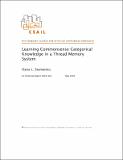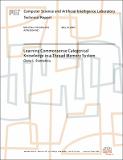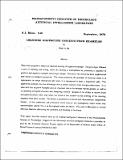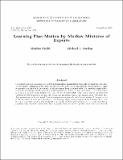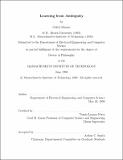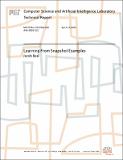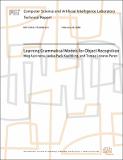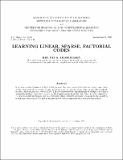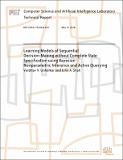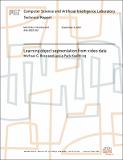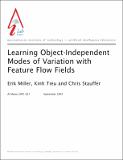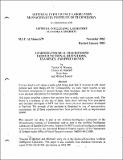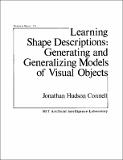Browsing Computer Science and Artificial Intelligence Lab (CSAIL) by Title
Now showing items 1811-1830 of 3804
-
Learning Classes Correlated to a Hierarchy
(2003-05-01)Trees are a common way of organizing large amounts of information by placing items with similar characteristics near one another in the tree. We introduce a classification problem where a given tree structure gives us ... -
Learning Commonsense Categorical Knowledge in a Thread Memory System
(2004-05-18)If we are to understand how we can build machines capable of broad purpose learning and reasoning, we must first aim to build systems that can represent, acquire, and reason about the kinds of commonsense knowledge that ... -
Learning Commonsense Categorical Knowledge in a Thread Memory System
(2004-05-18)If we are to understand how we can build machines capable of broadpurpose learning and reasoning, we must first aim to build systemsthat can represent, acquire, and reason about the kinds of commonsenseknowledge that we ... -
Learning complex cell invariance from natural videos: A plausibility proof
(2007-12-26)One of the most striking feature of the cortex is its ability to wire itself. Understanding how the visual cortex wires up through development and how visual experience refines connections into adulthood is a key question ... -
Learning Disjunctive Concepts From Examples
(1979-09-01)This work proposes a theory for machine learning of disjunctive concepts. The paradigm followed is one of teaching and testing, where the teaching is accomplished by presenting a sequence of positive and negative ... -
Learning Fine Motion by Markov Mixtures of Experts
(1995-11-01)Compliant control is a standard method for performing fine manipulation tasks, like grasping and assembly, but it requires estimation of the state of contact between the robot arm and the objects involved. Here we present ... -
Learning from Ambiguity
(1998-12-01)There are many learning problems for which the examples given by the teacher are ambiguously labeled. In this thesis, we will examine one framework of learning from ambiguous examples known as Multiple-Instance learning. ... -
Learning from Incomplete Data
(1995-01-24)Real-world learning tasks often involve high-dimensional data sets with complex patterns of missing features. In this paper we review the problem of learning from incomplete data from two statistical perspectives---the ... -
Learning From Snapshot Examples
(2005-04-13)Examples are a powerful tool for teaching both humans and computers.In order to learn from examples, however, a student must first extractthe examples from its stream of perception. Snapshot learning is ageneral approach ... -
Learning Generic Invariances in Object Recognition: Translation and Scale
(2010-12-30)Invariance to various transformations is key to object recognition but existing definitions of invariance are somewhat confusing while discussions of invariance are often confused. In this report, we provide an operational ... -
Learning Grammatical Models for Object Recognition
(2008-02-25)Many object recognition systems are limited by their inability to share common parts or structure among related object classes. This capability is desirable because it allows information about parts and relationships in ... -
Learning Linear, Sparse, Factorial Codes
(1996-12-01)In previous work (Olshausen & Field 1996), an algorithm was described for learning linear sparse codes which, when trained on natural images, produces a set of basis functions that are spatially localized, oriented, ... -
Learning Models of Sequential Decision-Making without Complete State Specification using Bayesian Nonparametric Inference and Active Querying
(2018-05-17)Learning models of decision-making behavior during sequential tasks is useful across a variety of applications, including human-machine interaction. In this paper, we present an approach to learning such models within ... -
Learning New Principles from Precedents and Exercises: The Details
(1981-11-01)Much Learning is done by way of studying precedents and exercises. A teacher supplies a story, gives a problem, and expects a student both to solve a problem and to discover a principle. The student must find the ... -
Learning object segmentation from video data
(2003-09-08)This memo describes the initial results of a project to create a self-supervised algorithm for learning object segmentation from video data. Developmental psychology and computational experience have demonstrated that the ... -
Learning object segmentation from video data
(2003-09-08)This memo describes the initial results of a project to create aself-supervised algorithm for learning object segmentation from videodata. Developmental psychology and computational experience havedemonstrated that the ... -
Learning Object-Independent Modes of Variation with Feature Flow Fields
(2001-09-01)We present a unifying framework in which "object-independent" modes of variation are learned from continuous-time data such as video sequences. These modes of variation can be used as "generators" to produce a manifold of ... -
Learning Physical Descriptions from Functional Definitions, Examples, and Precedents
(1982-11-01)It is too hard to tell vision systems what things look like. It is easier to talk about purpose and what things are for. Consequently, we want vision systems to use functional descriptions to identify things when ... -
Learning Semantic Scene Models by Trajectory Analysis
(2006-02-10)In this paper, we describe an unsupervised learning framework to segment a scene into semantic regions and to build semantic scene models from long-term observations of moving objects in the scene. First, we introduce two ... -
Learning Shape Descriptions: Generating and Generalizing Models of Visual Objects
(1985-09-01)We present the results of an implemented system for learning structural prototypes from grey-scale images. We show how to divide an object into subparts and how to encode the properties of these subparts and the relations ...


